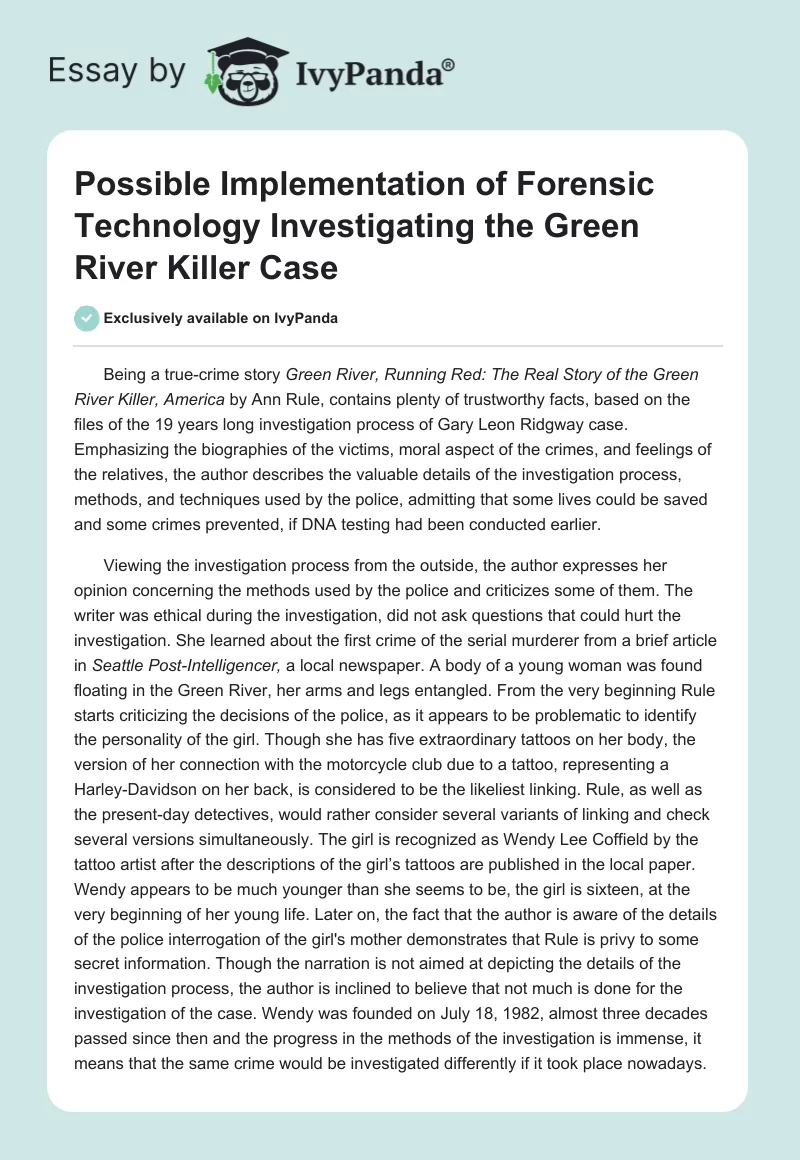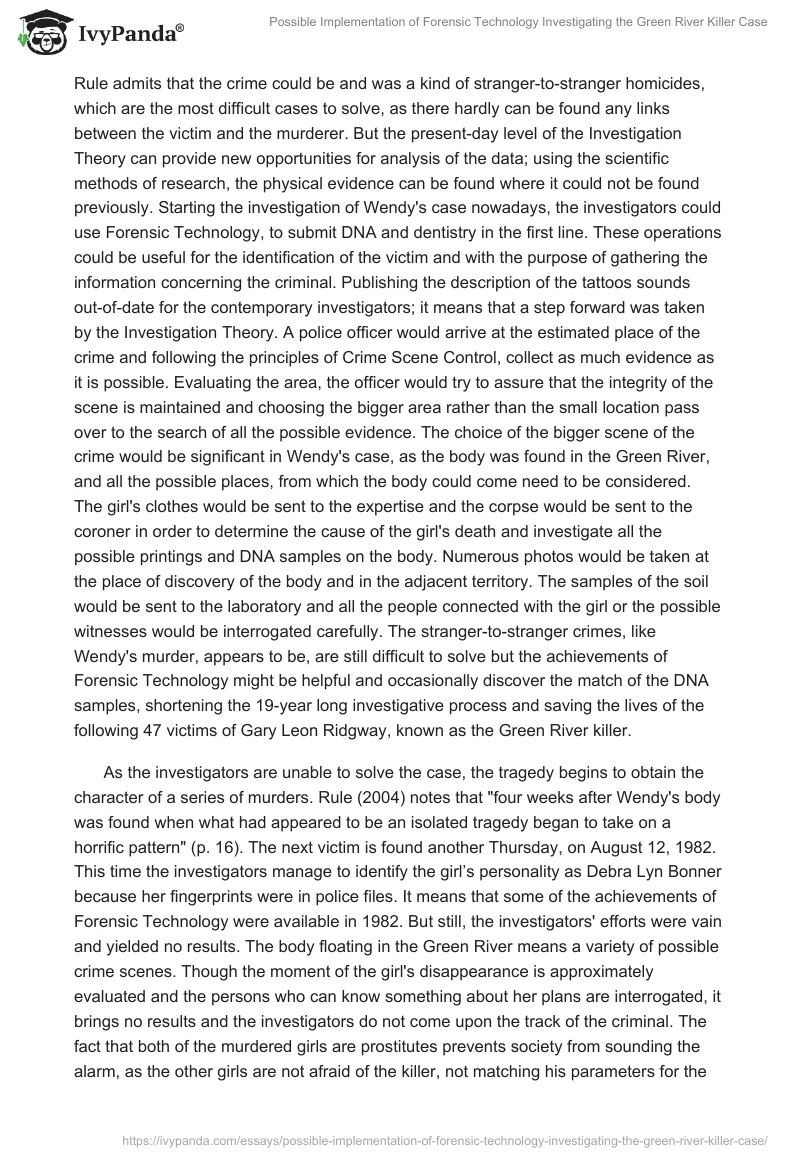Being a true-crime story Green River, Running Red: The Real Story of the Green River Killer, America by Ann Rule, contains plenty of trustworthy facts, based on the files of the 19 years long investigation process of Gary Leon Ridgway case. Emphasizing the biographies of the victims, moral aspect of the crimes, and feelings of the relatives, the author describes the valuable details of the investigation process, methods, and techniques used by the police, admitting that some lives could be saved and some crimes prevented, if DNA testing had been conducted earlier.
Viewing the investigation process from the outside, the author expresses her opinion concerning the methods used by the police and criticizes some of them. The writer was ethical during the investigation, did not ask questions that could hurt the investigation. She learned about the first crime of the serial murderer from a brief article in Seattle Post-Intelligencer, a local newspaper. A body of a young woman was found floating in the Green River, her arms and legs entangled. From the very beginning Rule starts criticizing the decisions of the police, as it appears to be problematic to identify the personality of the girl. Though she has five extraordinary tattoos on her body, the version of her connection with the motorcycle club due to a tattoo, representing a Harley-Davidson on her back, is considered to be the likeliest linking. Rule, as well as the present-day detectives, would rather consider several variants of linking and check several versions simultaneously. The girl is recognized as Wendy Lee Coffield by the tattoo artist after the descriptions of the girl’s tattoos are published in the local paper. Wendy appears to be much younger than she seems to be, the girl is sixteen, at the very beginning of her young life. Later on, the fact that the author is aware of the details of the police interrogation of the girl’s mother demonstrates that Rule is privy to some secret information. Though the narration is not aimed at depicting the details of the investigation process, the author is inclined to believe that not much is done for the investigation of the case. Wendy was founded on July 18, 1982, almost three decades passed since then and the progress in the methods of the investigation is immense, it means that the same crime would be investigated differently if it took place nowadays. Rule admits that the crime could be and was a kind of stranger-to-stranger homicides, which are the most difficult cases to solve, as there hardly can be found any links between the victim and the murderer. But the present-day level of the Investigation Theory can provide new opportunities for analysis of the data; using the scientific methods of research, the physical evidence can be found where it could not be found previously. Starting the investigation of Wendy’s case nowadays, the investigators could use Forensic Technology, to submit DNA and dentistry in the first line. These operations could be useful for the identification of the victim and with the purpose of gathering the information concerning the criminal. Publishing the description of the tattoos sounds out-of-date for the contemporary investigators; it means that a step forward was taken by the Investigation Theory. A police officer would arrive at the estimated place of the crime and following the principles of Crime Scene Control, collect as much evidence as it is possible. Evaluating the area, the officer would try to assure that the integrity of the scene is maintained and choosing the bigger area rather than the small location pass over to the search of all the possible evidence. The choice of the bigger scene of the crime would be significant in Wendy’s case, as the body was found in the Green River, and all the possible places, from which the body could come need to be considered. The girl’s clothes would be sent to the expertise and the corpse would be sent to the coroner in order to determine the cause of the girl’s death and investigate all the possible printings and DNA samples on the body. Numerous photos would be taken at the place of discovery of the body and in the adjacent territory. The samples of the soil would be sent to the laboratory and all the people connected with the girl or the possible witnesses would be interrogated carefully. The stranger-to-stranger crimes, like Wendy’s murder, appears to be, are still difficult to solve but the achievements of Forensic Technology might be helpful and occasionally discover the match of the DNA samples, shortening the 19-year long investigative process and saving the lives of the following 47 victims of Gary Leon Ridgway, known as the Green River killer.
As the investigators are unable to solve the case, the tragedy begins to obtain the character of a series of murders. Rule (2004) notes that “four weeks after Wendy’s body was found when what had appeared to be an isolated tragedy began to take on a horrific pattern” (p. 16). The next victim is found another Thursday, on August 12, 1982. This time the investigators manage to identify the girl’s personality as Debra Lyn Bonner because her fingerprints were in police files. It means that some of the achievements of Forensic Technology were available in 1982. But still, the investigators’ efforts were vain and yielded no results. The body floating in the Green River means a variety of possible crime scenes. Though the moment of the girl’s disappearance is approximately evaluated and the persons who can know something about her plans are interrogated, it brings no results and the investigators do not come upon the track of the criminal. The fact that both of the murdered girls are prostitutes prevents society from sounding the alarm, as the other girls are not afraid of the killer, not matching his parameters for the choice of the victims. Surely, it is impossible to investigate and gather the samples when the actual scene of the crime is unknown. The bigger scene deprives the investigators of many of the important sources of physical evidence. It is hard to believe that the present-day investigators could not find any tracks of the criminal within the period of 19 years. In fact, before the introduction of the DNA analysis practice into the investigative process, there was no other way to solve the case. Stranger-to-stranger homicides in the desert locations with no witnesses, the bodies floating in the river, lack of a smaller scene of the crime complicate the investigative process immensely. Profiling working with the corpses only yields few results. Swanson et al. (2009) noted that the main purpose of profiling is “to identify and interpret certain items of evidence at the crime scene which would be indicative of the personality type of the individual or the individuals committing the crime” (p. 76). On the other hand, it is almost impossible that the murderer leaves no materials for DNA analysis on the body of the victim. The girls are sure to maintain resistance and during the struggle, they are sure to hurt the killer and get some piece of his skin or hair carrying the DNA information. The murder’s choice of the prostitutes as his victims is not occasional as well; as the lifestyle of the girls means that there are not so many people who are going to look for them. Some of the bodies were not discovered before they transformed into the skeletons, four corpses were not identified at all. Rule’s book demonstrates the inconsistency of the polygraph testing method in some cases, while the mistakes made in the investigative processes may have tragic results. The investigation of these series of murders would be problematic for the present-day investigators as well, but having Forensic Technology at their disposal might be helpful. On the other hand, human resources remain a significant factor as well, as no technologies can be useful without the policemen skills and thorough knowledge of opportunities for their implementation.
Using the modern achievement of Forensic Technology and following the modern schemes and principles of the investigative process could prevent the 48 murders committed by Gary Leon Ridgway and describe in a true crime story Green River, Running Red: The Real Story of the Green River Killer, America by Ann Rule.
Bibliography
Rule, Ann (2004) Green River, Running Red: The Real Story of the Green River Killer, America. Free Press.
Swanson, Charles, Chamelin, Neil, Rule, Ann (2009). Criminal Investigations. 10th edition. McGraw-Hill.


